2018 MERCEDES-BENZ S-CLASS SEDAN air condition
[x] Cancel search: air conditionPage 25 of 562
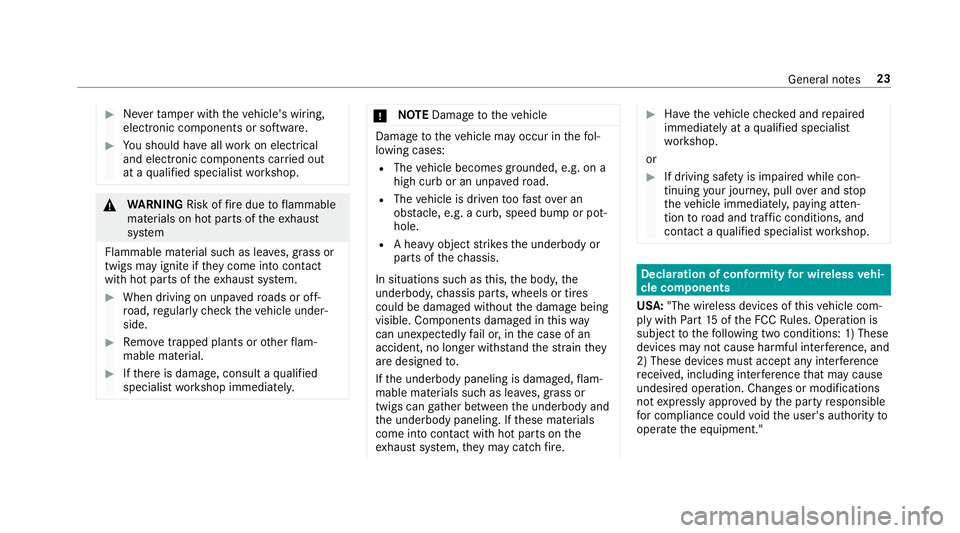
#Neverta mp er with theve hicle's wiring,
electronic components or software.
#Yo u should ha veall workon electrical
and electronic components car ried out
at a qualified specialist workshop.
&
WARNING Risk offire due toflammable
materials on hot parts of theex haust
sy stem
Flammable material such as lea ves, grass or
twigs may ignite if they come into contact
wi th hot parts of theex haust sy stem.
#When driving on unpa vedro ads or off-
ro ad, regular lych eck theve hicle under‐
side.
#Re mo vetrapped plants or other flam‐
mable material.
#If th ere is damage, consult a qualified
specialist workshop immediately.
* NO
TEDama getotheve hicle
Damage totheve hicle may occur in thefo l‐
lowing cases:
RThe vehicle becomes grounded, e.g. on a
high curb or an unpa vedro ad.
RThe vehicle is driven toofast over an
obs tacle, e.g. a curb, speed bump or pot‐
hole.
RA heavy object strike sth e underbody or
parts of thech assis.
In situations such as this, the body, the
underbody, chassis parts, wheels or tires
could be damaged without the damage being
visible. Components damaged in this wa y
can unexpectedly fail or, in the case of an
accident, no longer withs tand thest ra in they
are designed to.
If th e underbody paneling is damaged, flam‐
mable materials such as lea ves, grass or
twigs can gather between the underbody and
th e underbody paneling. If these materials
come into conta ct withhot parts on the
ex haust sy stem, they may catch fire .
#Ha ve theve hicle checked and repaired
immediately at a qualified specialist
wo rkshop.
or
#If driving saf etyis impaired while con‐
tinuing your journe y,pull over and stop
th eve hicle immediatel y,paying atten‐
tion toroad and traf fic conditions, and
contact a qualified specialist workshop.
Declaration of conformity for wi reless vehi‐
cle co mponents
USA: "The wireless devices of this vehicle com‐
ply with Part15 ofthe FCC Rules. Operation is
subject tothefo llowing two conditions: 1) These
devices may not cause harmful inter fere nce, and
2) These devices must accept any interfere nce
re ceive d, including inter fere nce that may cause
undesired operation. Change s or modifications
not expressly appr ovedby the party responsible
fo r compliance could void the user's authority to
operate the equipment."
General no tes 23
Page 29 of 562

Rstatus messages concerning theve hicle and
its individual components (e.g. number of
wheel revo lutions/speed, decele ration, lat‐
eral acceleration, display of thefast ened seat
belts)
Rmalfunctions or defects in impor tant sy stem
components (e.g. lights, brakes)
Rinformation on vehicle damage events
Rsystem reactions in special driving situations
(e.g. air bag deployment, inter vention of sta‐
bility control sy stems)
Rambient conditions (e.g. temp erature, rain
sensor)
In addition toprov iding the actual control unit
function, this data assists the manufacturer in
de tecting and rectifying malfunctions and opti‐
mizing vehicle functions. The majority of this
data is temp orary and is only processed in the
ve hicle itself. Only a small portion of the data is
st ored in theev ent or malfunction memor y.
When your vehicle is serviced, tech nical da ta
from theve hicle can be read out byservice net‐
wo rkemplo yees or third parties. Services
include repair services, maintenance processes, wa
rranty events and quality assurance meas‐
ures, forex ample. The read out is per form ed via
th e legally prescribed port for OBD ("on-board
diagnostics") in theve hicle. The respective
service network locations or third parties col‐
lect, process and use the data. They document
te ch nical statuses of theve hicle, assist in
find
‐
ing malfunctions and impr oving quality and are
transmitte dto the manufacturer, if necessar y.
Fu rthermore, the manufacturer is subject to
product liability. Forth is, the manufacturer
re qu ires tech nical da tafrom vehicles.
Malfunction memories in theve hicle can be
re set bya service outlet as part of repair or
maintenance work.
They can enter data into theve hicle's con veni‐
ence and inf otainment functions themselves as
part of the selected equipment.
This includes, forex ample:
Rmultimedia data such as music, films or pho‐
to sfo r playba ckin an integrated multimedia
sy stem
Raddress book data for use in connection with
an integrated hands-free sy stem or an inte‐
grated navigation sy stem
Rentered navigation destinations
Rdata about the use of Internet services
This data can be stored locally in theve hicle or
is located on a device which you ha veconnected
to theve hicle. If this data is stored in theve hi‐
cle, you can dele teit at any time. This data can
only be transmitte dto third parties upon your
re qu est with particular rega rd tothe scope of
use of online services according to your selected
settings.
Yo u can store or change con venience settings/
individualization in theve hicle at any time.
Depending on the eq uipment,
this in
cludes,for
ex ample:
Rseat and steering wheel position settings
Rsuspension and climate control settings
Rindividualization such as interior lighting
If yo ur vehicle is accordingly equipped, you can
connect your smartphone or ano ther mobile end
General no tes 27
Page 31 of 562
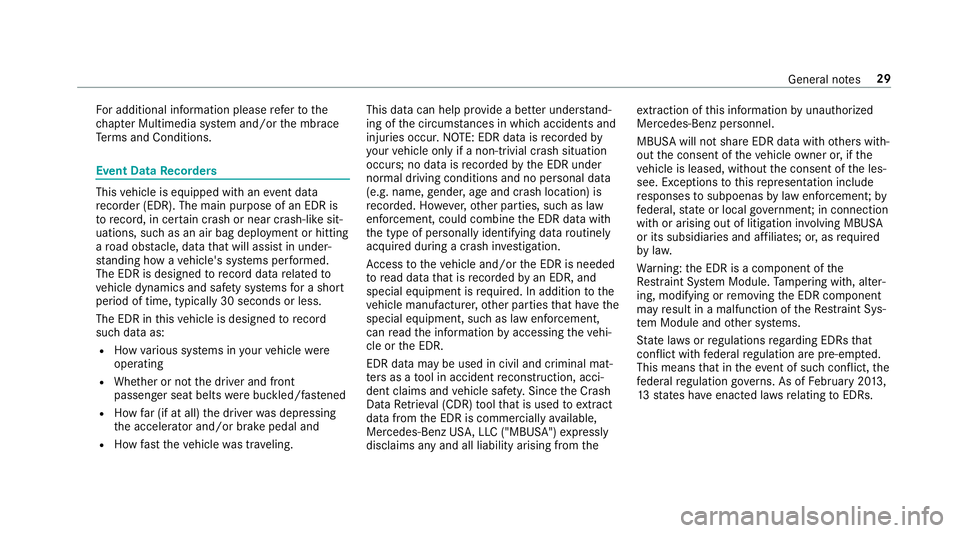
For additional information please referto the
ch ap ter Multimedia sy stem and/or the mbrace
Te rm s and Conditions.
Event Data Recorders
This vehicle is equipped with an event data
re corder (EDR). The main purp ose of an EDR is
to record, in cer tain crash or near crash-like sit‐
uations, such as an air bag deployment or hitting
a ro ad obs tacle, data that will assist in under‐
st anding how a vehicle's sy stems per form ed.
The EDR is designed torecord data related to
ve hicle dynamics and saf etysy stems for a short
period of time, typically 30 seconds or less.
The EDR in this vehicle is designed torecord
such data as:
RHowvarious sy stems in your vehicle were
operating
RWhe ther or not the driver and front
passenger seat belts werebuckled/fas tened
RHow far (if at all) the driver was depressing
th e accelera tor and/or brake pedal and
RHow fasttheve hicle was tr aveling. This data can help pr
ovide a better under stand‐
ing of the circums tances in which accidents and
inju ries occur. NOTE: EDR data is recorded by
yo ur vehicle only if a non-trivial crash situation
occurs; no data is recorded bythe EDR under
normal driving conditions and no personal data
(e.g. name, gende r,age and crash location) is
re corded. Ho wever,ot her parties, such as law
enforcement, could combine the EDR data with
th e type of personally identifying data routinely
acquired during a crash inve stigation.
Ac cess tothe
ve hicle and/or the E
DR is needed
to read data that is recorded byan EDR, and
special equipment is required. In addition tothe
ve hicle manufacturer, other parties that ha vethe
special equipment, such as law enforcement,
can read the information byaccessing theve hi‐
cle or the EDR.
EDR data may be used in civil and criminal mat‐
te rs as a tool in accident reconstruction, acci‐
dent claims and vehicle saf ety. Since the Crash
Data Retrie val (CDR) tool that is used toextract
da ta from the EDR is commercially available,
Mercedes-Benz US A,LLC ("MBUSA") expressly
disclaims any and all liability arising from the ex
traction of this information byunauthorized
Mercedes-Benz personnel.
MBUSA will not share EDR data withot hers with‐
out the consent of theve hicle owner or, if the
ve hicle is leased, without the consent of the les‐
see. Exceptions tothis representation include
re sponses tosubpoenas bylaw enforcement; by
fe deral, state or local go vernment; in connection
with or arising out of litigation in volvin g MBUSA
or its subsidiari es and affiliates; or, as requ ired
by law.
Wa rning: the EDR is a component of the
Re stra int Sy stem Module. Tamp ering with, alter‐
ing, modifying or removing the EDR component
may result in a malfunction of theRe
stra in
t Sys‐
te m Module and other sy stems.
St ate la wsorregulations rega rding EDRs that
con flict with federal regulation are pre-em pted.
This means that in theeve nt of such conflict,the
fe deral regulation go verns. As of February 20 13,
13 states ha veenacted la wsrelating toEDRs.
General no tes 29
Page 35 of 562
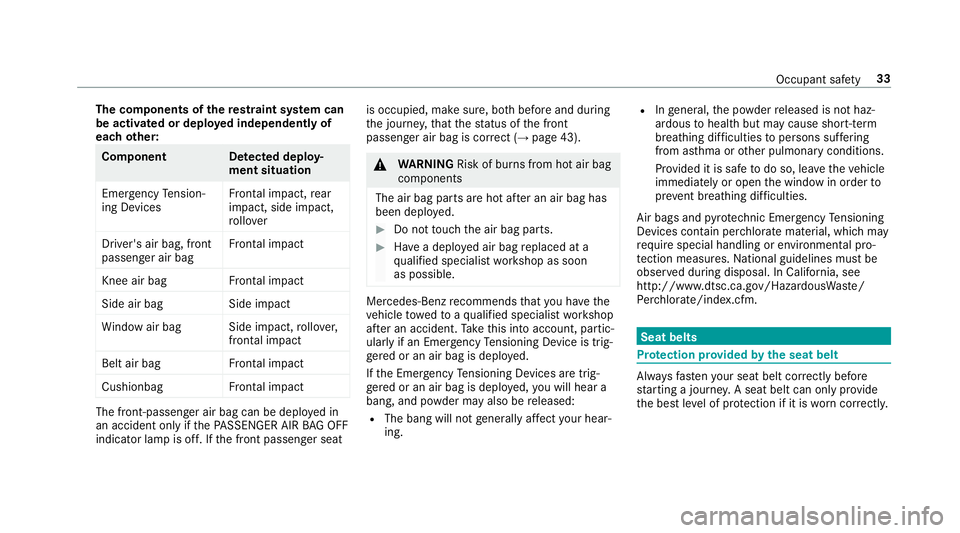
The components of there stra int sy stem can
be activated or deplo yed independently of
each other:
Component De tected deploy‐
ment situation
Emer gency Tension‐
ing Devices Fr
ontal impact, rear
impact, side impact,
ro llo ver
Driver's air bag, front
passenger air bag Fr
ontal impact
Knee air bag Frontal impact
Side air bag Side impact
Wi ndow air ba gS ide impact,rollo ver,
frontal impact
Belt air bag Frontal impact
Cushionbag Frontal impact
The front-passenger air bag can be deplo yed in
an accident only if thePA SSENGER AIR BAG OFF
indicator lamp is off. If the front passenger seat is occupied, make sure, bo
thbefore and during
th e journe y,that thest atus of the front
passenger air bag is cor rect (
→page 43).
&
WARNING Risk of burn s from hot air bag
components
The air bag parts are hot af ter an air bag has
been deploy ed.
#Do nottouch the air bag parts.
#Ha ve a deplo yed air bag replaced at a
qu alified specialist workshop as soon
as possible.
Mercedes-Benz recommends that you ha vethe
ve hicle towe dto aqu alified specialist workshop
af te r an accident. Take this into account, partic‐
ularly if an Emer gency Tensioning Device is trig‐
ge red or an air bag is deplo yed.
If th e Emer gency Tensioning Devices are trig‐
ge red or an air bag is deplo yed, youwill hear a
bang, and po wdermay also be released:
RThe bang will not generally af fect your hear‐
ing.
RIn general, the powder released is not haz‐
ardous tohealth but may cause short-term
breathing dif ficulties topersons suf fering
from as thma or other pulmonary conditions.
Pr ov ided it is safe todo so, lea vetheve hicle
immediately or open the window in order to
pr eve nt brea thing dif ficulties.
Air bags and pyrotech nic Emergency Tensioning
Devices contain pe rchlorate material, which may
re qu ire special handling or environmental pro‐
te ction measure s.Na tional guidelines must be
obser ved during disposal. In California, see
http://www.dtsc.ca.gov/HazardousWas te/
Pe rchlorate/index.cfm.
Seat belts
Pr otection pr ovided bythe seat belt
Alw aysfast enyour seat belt co rrectly before
st arting a journe y.A seat belt can only pr ovide
th e best le vel of pr otection if it is worncor rectl y.
Occupant saf ety 33
Page 90 of 562

Notes onthe cor rect driver's seat position
&
WARNING Risk of injury from adjusting
th eve hicle settings while theve hicle is in
motion
Yo u could lose cont rol of theve hicle in the
fo llowing situations:
Rifyo u adjust the driver's seat, the head
re stra int, thesteering wheel or the mir ror
while theve hicle is in motion
Rifyo ufa sten your seat belt while theve hi‐
cle is in motion
#Before starting the engine: adjust the
driver's seat, the head restra int, the
st eering wheel or the mir ror and fasten
yo ur seat belt.
Obser vethefo llowing when adjusting steering
wheel 1, seat belt 2and driver's seat 3:
Ryou are as faraw ay from the driver's airbag
as possible
Ryo u are sitting in a no rmal upright position
Ryour thighs are slightly supportedby the seat
cushion
Ryo ur legs are not entirely stre tched and you
can dep ress the pedals properly
Rthe back of your head is support ed ateye
le ve lby the center of the head restra int
Ryo u can hold thesteering wheel with your
arms slightly bent
Ryo u can mo veyour legs freely
Ryou can see all the displa ysinthe instrument
clus ter clearl y
Ryou should ha vea good overview of traf fic
conditions
Rth e seat belt is pulled snugly against the
body and must be routed across the center
of your shoulder and across your hips in the
pelvic area
88 Seats and stowing
Page 142 of 562
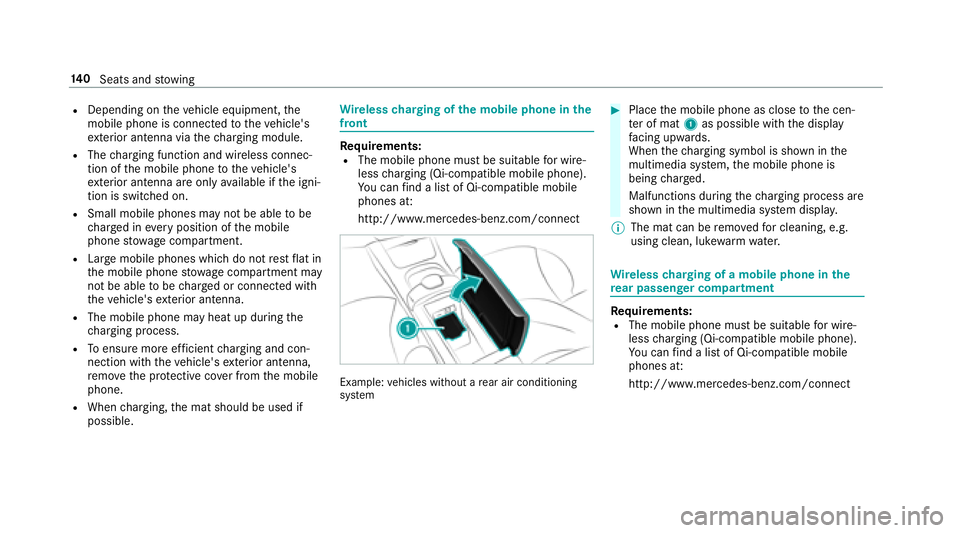
RDepending ontheve hicle equipment, the
mobile phone is connected totheve hicle's
ex terior antenna via thech arging module.
RThe charging function and wireless connec‐
tion of the mobile phone totheve hicle's
ex terior antenna are only available if the igni‐
tion is switched on.
RSmall mobile phones may not be able tobe
ch arge d in every position of the mobile
phone stowage compartment.
RLargemobile phones which do not rest flat in
th e mobile phone stowage compartment may
not be able tobe charge d or connec ted with
th eve hicle's exterior antenna.
RThe mobile phone may heat up during the
ch arging process.
RTo ensure more ef ficient charging and con‐
nection with theve hicle's exterior antenna,
re mo vethe pr otective co ver from the mobile
phone.
RWhen charging, the mat should be used if
possible.
Wire lesscharging of the mobile phone in the
front
Re quirements:RThe mobile phone must be suitable for wire‐
less charging (Qi-compatible mobile phone).
Yo u can find a li stof Qi-compatible mobile
phones at:
http://www.mercedes-benz.com/connect
Example: vehicles without a rear air conditioning
sy stem
#Place the mobile phone as close tothe cen‐
te r of mat 1as possible with the display
fa cing up wards.
When thech arging symbol is shown in the
multimedia sy stem, the mobile phone is
being charge d.
Malfunctions during thech arging process are
shown in the multimedia sy stem displa y.
% The mat can be remo vedfo r cleaning, e.g.
using clean, luk ewarmwate r.
Wire lesscharging of a mobile phone in the
re ar passenger co mpartment
Requirements:RThe mobile phone must be suitable for wire‐
less charging (Qi-compatible mobile phone).
Yo u can find a li stof Qi-compatible mobile
phones at:
http://www.mercedes-benz.com/connect
14 0
Seats and stowing
Page 148 of 562
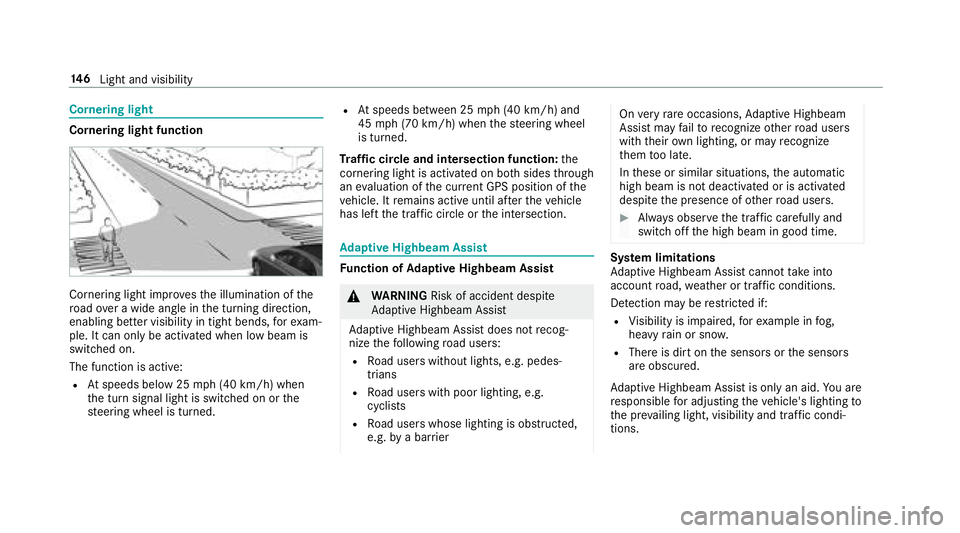
Cornering light
Cornering light function
Cornering light improvesth e illumination of the
ro ad ove r a wide angle in the turning direction,
enabling better visibility in tight bends, forex am‐
ple. It can only be activated when low beam is
switch ed on.
The function is active:
RAt speeds below 25 mph (40 km/h) when
th e turn signal light is switched on or the
st eering wheel is turned.
RAt speeds between 25 mph (40 km/h) and
45 mph (70 km/h) when thesteering wheel
is turned.
Tr af fic circle and intersection function: the
cornering light is acti vated on bo thsides thro ugh
an evaluation of the cur rent GPS position of the
ve hicle. It remains active until af terth eve hicle
has left the traf fic circle or the intersection.
Ad aptive Highbeam Assist
Function of Adaptive Highbeam Assist
&
WARNING Risk of accident despite
Ad aptive Highbeam Assist
Ad aptive Highbeam Assist does not recog‐
nize thefo llowing road users:
RRo ad users without lights, e.g. pedes‐
trians
RRo ad users with poor lighting, e.g.
cyclists
RRo ad users whose lighting is obstructed,
e.g. bya bar rier
On very rare occasions, Adaptive Highbeam
Assist may failto recognize other road users
with their own lighting, or may recognize
th em too late.
In these or similar situations, the automatic
high beam is not deactivated or is activated
despite the presence of other road users.
#Alw ays obser vethe tra ffic carefully and
switch off the high beam in good time.
Sy stem limitations
Ad aptive Highbeam Assist cannot take into
account road, weather or traf fic conditions.
De tection may be restricted if:
RVi sibility is impaired, forex ample in fog,
heavy rain or sno w.
RThere is dirt on the sensors or the sensors
are obscured.
Ad aptive Highbeam Assist is only an aid.You are
re sponsible for adju sting theve hicle's lighting to
th e pr evailing light, visibility and traf fic condi‐
tions.
14 6
Light and visibility
Page 159 of 562
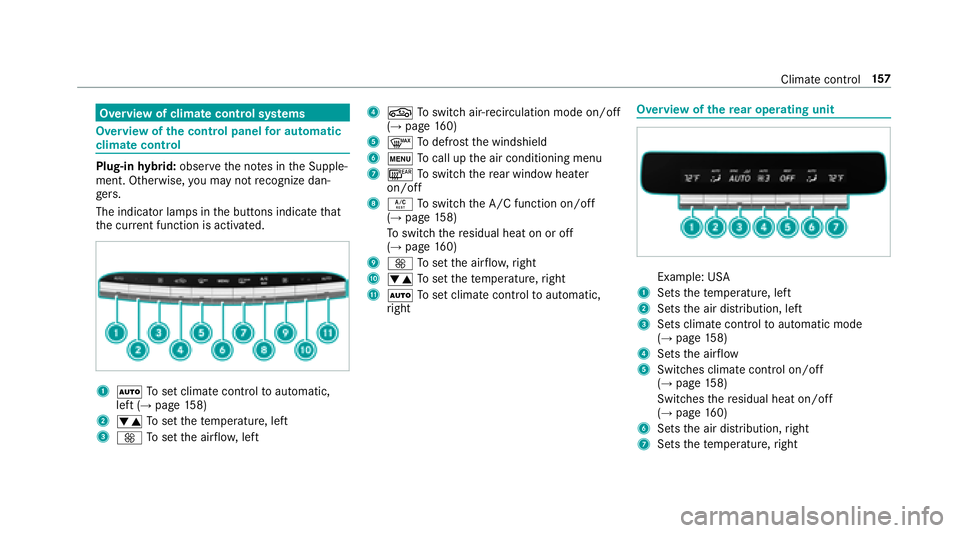
Overview of climate control systems
Overview of the control panel for automatic
climate control
Plug-in hybrid: obser vethe no tes in the Supple‐
ment. Otherwise, you may not recognize dan‐
ge rs.
The indicator lamps in the buttons indicate that
th e cur rent function is acti vated.
1Ã Toset climate contro lto automatic,
left (→page 158)
2w Toset thete mp erature, left
3K Toset the air flow , left
4g Toswitch air-recirculation mode on/off
(→page 160)
5¬ Todefrost the windshield
6t Tocall up the air conditioning menu
7¤ Toswitch there ar wind owheater
on/off
8Á Toswitch the A/C function on/off
(→page 158)
To switch there sidual heat on or off
(
→page 160)
9K Toset the air flow ,ri ght
Aw Toset thete mp erature, right
BÃ Toset climate contro lto automatic,
ri ght
Overview of there ar operating unit
Example: USA
1Sets thete mp erature, left
2Sets the air distribution, left
3Sets climate control toautomatic mode
(→page 158)
4Sets the air flow
5Switches climate control on/off
(→pa ge 158)
Switches there sidual heat on/off
(
→page 160)
6Sets the air distribution, right
7Sets thete mp erature, right
Climate contro l15
7